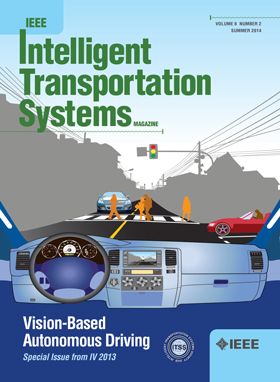在复杂环境中利用可变结构交互多重模型对周围车辆状态进行移动地平线估计
IF 8.4
1区 工程技术
Q1 ENGINEERING, CIVIL
IEEE Transactions on Intelligent Transportation Systems
Pub Date : 2024-10-07
DOI:10.1109/TITS.2024.3467042
引用次数: 0
摘要
在复杂环境中对周围车辆进行运动预测对于自动驾驶车辆的轨迹规划至关重要。精确的运动预测需要准确估计周围车辆的状态信息。为此,本文首次提出了一种具有交互多模型(IMM-MHE)的移动地平线估计算法。该算法不仅能匹配多个车辆操纵,还能充分利用驾驶过程中获得的历史信息,实现较高的估计精度。其次,设计了一种具有可变结构交互多重模型(VSIMM-MHE)的移动水平估计框架。提出了时域自适应方法,以解决由于模型激活和消除导致某些模型的固定时域无法填充的问题。提出了一种新的交互方法,以解决因模型时域的起始时间步不同而无法交互的问题。所提出的框架不仅减轻了计算负担,还减少了因模型与当前操纵不匹配而造成的最终估计误差。第三,基于由不同类型意图模型组成的模型集,提出了一种 VSIMM-MHE 算法。该算法在模型分类方法中引入了残差信息,降低了对模型概率准确性的依赖。它不仅能在复杂环境中准确估计周围车辆的状态信息,还能识别与当前操纵最匹配的模型,并通过模型概率有效预测周围车辆的运动轨迹。最后,通过 SCANeR studio、Carsim 和 Simulink 的联合仿真以及硬件在环实验,不仅证明了所提出的两种估计算法的有效性,还证明了 VSIMM-MHE 算法中使用模型概率预测周围车辆运动的有效性。本文章由计算机程序翻译,如有差异,请以英文原文为准。
Moving Horizon Estimation With Variable Structure Interacting Multiple Model for Surrounding Vehicle States in Complex Environments
Motion prediction of surrounding vehicles in complex environments is essential for autonomous vehicle trajectory planning. Accurate motion prediction requires accurately estimating the state information of the surrounding vehicles. For this purpose, a moving horizon estimation with interacting multiple model (IMM-MHE) algorithm is first proposed here. The algorithm can match multiple vehicle maneuvers, but also fully utilizes the historical information obtained during the driving process, achieving a high estimation accuracy. Second, a moving horizon estimation with variable structure interacting multiple model (VSIMM-MHE) framework is designed. Time-domain adaptation is proposed to solve the problem that the fixed time domain of some models cannot be filled due to model activation and elimination. A new interaction method is proposed to solve the problem that models cannot interact because the starting timesteps of their time domains are different. The proposed framework reduces not only the computational burden, but also the final estimation error caused by the model not matching the current maneuver. Third, based on a model set consisting of different kinds of intention models, a VSIMM-MHE algorithm is proposed. This algorithm introduces residual information into the model classification method, reducing the dependence on the accuracy of the model probabilities. It can not only accurately estimate the state information of surrounding vehicles in a complex environment, but also identify the model that best matches the current maneuver and effectively predict the motion trajectories of surrounding vehicles through model probabilities. Finally, joint simulation with SCANeR studio, Carsim and Simulink and hardware-in-the-loop experiment demonstrate the effectiveness of not only the two proposed estimation algorithms but also the motion prediction of surrounding vehicles using the model probabilities in the VSIMM-MHE algorithm.
求助全文
通过发布文献求助,成功后即可免费获取论文全文。
去求助
来源期刊

IEEE Transactions on Intelligent Transportation Systems
工程技术-工程:电子与电气
CiteScore
14.80
自引率
12.90%
发文量
1872
审稿时长
7.5 months
期刊介绍:
The theoretical, experimental and operational aspects of electrical and electronics engineering and information technologies as applied to Intelligent Transportation Systems (ITS). Intelligent Transportation Systems are defined as those systems utilizing synergistic technologies and systems engineering concepts to develop and improve transportation systems of all kinds. The scope of this interdisciplinary activity includes the promotion, consolidation and coordination of ITS technical activities among IEEE entities, and providing a focus for cooperative activities, both internally and externally.
 求助内容:
求助内容: 应助结果提醒方式:
应助结果提醒方式:


